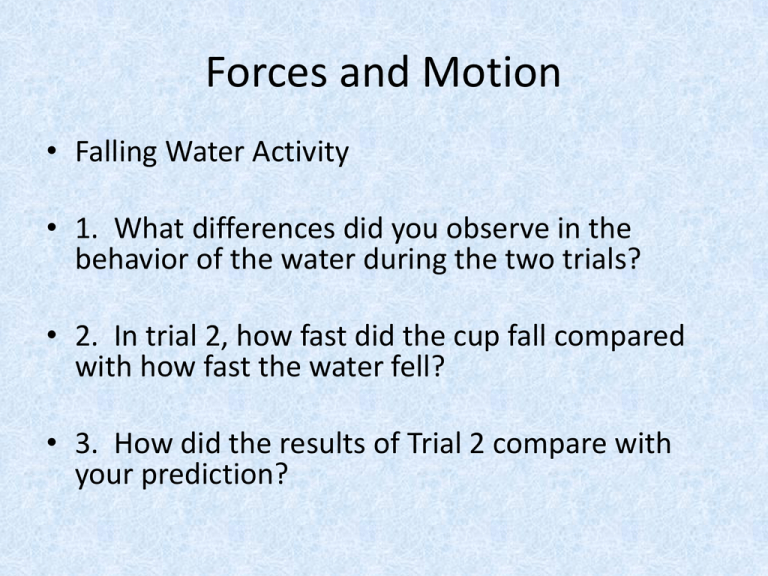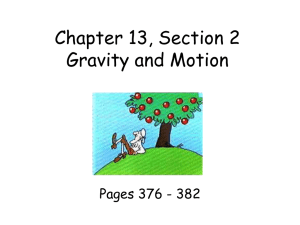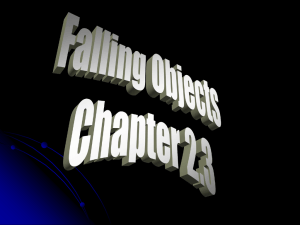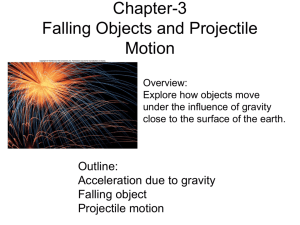Chapter 2 Forces & Motion ppt - Mrs. Althoff's Science Class
advertisement

Forces and Motion • Falling Water Activity • 1. What differences did you observe in the behavior of the water during the two trials? • 2. In trial 2, how fast did the cup fall compared with how fast the water fell? • 3. How did the results of Trial 2 compare with your prediction? Aristotle • 400 BCE • He thought that the rate at which an object falls depended on the object’s mass. • He never tested his idea about falling objects Galileo • 1500’s • He questioned Aristotle’s idea about falling objects. • He argued that the mass of an object does not affect the time the object takes to fall to the ground. • It is believed that he dropped 2 cannon balls of different masses from the Tower of Pisa. • They landed at the same time. Why do objects fall to the ground at the same rate? • Because the acceleration due to gravity is the same for all objects. How is this possible? • Acceleration depends on force and mass. • A heavier object has more gravitational force than a lighter object. • A heavier object is harder to accelerate because of it’s greater mass. • The extra mass of the heavier object exactly balances the additional gravitational force. • Look at figure 1 on page 36 Acceleration • It is the rate at which velocity changes over time. • All objects accelerate toward Earth at a rate of 9.8 meters per second per second, so 9.8 m/s/s or 9.8 m/s². • Every second that an object falls, the object’s downward velocity increases by 9.8 m/s. Velocity of Falling Objects • To calculate the change in velocity of a falling object use the following equation: ∆v = g x t 1. ∆ means “change in” This is the difference between the final velocity and the starting velocity. 2. g = the acceleration due to gravity on Earth (9.8 m/s²) 3. t = the time the object takes to fall (in seconds) Calculating the Velocity of Falling Objects A stone at rest is dropped from a cliff, and the stone hits the ground after a time of 3 seconds. What is the stone’s velocity when it hits the ground? Step 1: ∆v = g x t Step 2: Replace the g with its value and t with the time given in the problem, and solve. • • • • ∆v = 9.8 m/s/s x 3 s The seconds will x out. So, 9.8 m/s x 3 ∆v = 29.4 m/s downward To rearrange the equation to find time, divide by the acceleration due to gravity. t = ∆v g Practice Problems: 1. A penny at rest is dropped from the top of a tall stairwell. What is the penny’s velocity after it has fallen for 2s? Answer: • 9.8 m/s/s x 2s • X out one second on each side. • 9.8 m/s x 2 = 19.6 m/s downward • 2. The same penny hits the ground in 4.5 s. What is the penny’s velocity as it hits the ground? Answer: 9.8 m/s/s x 4.5 s ∆v = 44.1 m/s • A marble at rest is dropped from a tall building. The marble hits the ground with a velocity of 98 m/s. How long was the marble in the air? t = ∆v g Answer: 98 m/s 9.8 m/s/s = 10 s • An acorn at rest falls from an oak tree. The acorn hits the ground with a velocity of 14.7 m/s. How long did it take the acorn to land? Answer: 14.7 m/s 9.8 m/s/s = 1.5 s • Falling Object You Tube • Falling Objects Air Resistance • It is the force that opposes the motion of objects through air. • The amount of air resistance acting on an object depends on the size, shape, and speed of the object. • Crumpled paper vs. a flat sheet of paper Terminal Velocity • It is when the object falls at a constant velocity. • As the speed of falling objects increases, air resistance increases. • Upward force of the air resistance continues to increase until is equal to the downward force of gravity. • The net force is 0. The object stops accelerating. How does terminal velocity help us? • The terminal velocity of hailstones is between 5 and 40 m/s. • Without air resistance, hailstones would hit Earth at velocities of 350 m/s. • Look at figure 4. Terminal velocity • http://www.youtube.com/watch?v=MQ7N6VYKJ8 Free Fall • An object is in free fall only if gravity is pulling it down and no other forces are acting on it. • So, free fall occurs when there is no air. • Where does this occur? • Space and a vacuum Free Fall- The motion of a body when only the force of gravity is acting on the body. Vacuum• A place where there is no matter. • Look at figure 5. Look at figure 6 on page 39 • Why is she floating? • She is not weightless. It is impossible for any object to be weightless anywhere in the universe that we know of. • Weight is a measure of gravitational force. The size of that force depends on the masses of objects and the distances between them. • Because objects still have mass, gravity would attract you to other objects (even if slightly), so you would still have some weight. • http://www.teachersdomain.org/asset/phy03 _vid_asrnt/ Why doesn’t the shuttle fall to Earth if gravity is pulling downward on it? The forward motion of the shuttle occurs together with free fall to produce a path that follows the curve of Earth’s surface. Orbiting• An object is orbiting when it is traveling around another object in space. • The space shuttle is always falling while it is in orbit. • Two motions are occurring: • Space craft moving forward • A downward force caused by gravity (free fall) These two forces cause the curved path. How spacecraft orbits • http://www.qrg.northwestern.edu/projects/vs s/docs/space-environment/1-what-causes-anorbit.html How an Orbit is Formed • Look at figure 7 on page 40 a. The space shuttle moves forward at a constant speed. If there were no gravity, the space shuttle would follow the path of the dotted line. b. The space shuttle is in free fall because gravity pulls it toward Earth. The space shuttle would move straight down if it were not traveling forward. c. The path of the space shuttle follow the curve of Earth’s surface. Following this path is known as orbiting. What would happen if the shuttle started moving much faster or much slower? • If it moved fast enough, it would escape Earth’s gravitational forces and move off into space. If it moved more slowly, it would begin to fall toward Earth. • The space shuttle slows down to land in a controlled fall toward Earth. However, the shuttle continues to move forward so it spirals down toward Earth rather than falling straight down. • http://spaceflight.nasa.gov/realdata/tracking/ind ex.html • http://www.nasa.gov/multimedia/nasatv/on_de mand_video.html?param=http://anon.nasaglobal.edgesuite.net/anon.nasaglobal/ksc/ksc_031010_itow_gernhardt.asx|http: //anon.nasa-global.edgesuite.net/anon.nasaglobal/ksc/ksc_031010_itow_gernhardt.asx&_id= 226912&_t • http://www.spacegrant.hawaii.edu/class_acts /Orbits.html Other objects that orbit: • The moon, spacecrafts, satellites, planets, • An object moving in a circular path is constantly changing direction. There must be an unbalanced force working on an object in circular motion. Centripetal force• The unbalanced force that causes objects to move in a circular path. • Centripetal means “toward the center” • Look at figure 8 on page 40 Centripetal Force • http://www.teachersdomain.org/asset/lsps07 _int_circmotion/ Projectile Motion• It is the curved path an object follows when it is thrown or propelled near the surface of the Earth. • Projectile motion has two components: 1. 2. Horizontal motion Vertical motion • When these two motions are combined, they form a curved path. • Examples: • • • • • A hopping grasshopper A bullfrog jumping Water falling from a sprinkler An arrow shot by an archer A swimmer diving into the water Look at figure 9 on page 41 Horizontal Motion-motion parallel to the ground. • When you throw a ball, your hand exerts a force on the ball that makes the ball move forward. • No horizontal forces are acting on the ball (ignoring air resistance). • Gravity does not affect this type of motion. • So, horizontal motion is constant after ball is released. • http://physicsquest.homestead.com/quest3n.html • http://teachingphysics.wordpress.com/2009/03/01/projectilemotion-activity/ • http://www.explorelearning.com Vertical Motion • It is motion that is perpendicular to the ground. • Gravity pulls objects in projectile motion down at an acceleration of 9.8 m/s² (ignoring air resistance). • The downward acceleration of a thrown object and a falling object are the same. • shoot the monkey • Explanation • http://www.explorelearning.com • monkey and the hunter Aim Above the Target • Because objects in projectile motion accelerate downward, you always have to aim above the target. • http://sciencespot.net/Media/newtonlab.pdf • http://www.wisconline.com/Objects/ViewObject.aspx?ID=TP1 202 • http://www.batesville.k12.in.us/physics/PHYN ET/Mechanics/Newton1/Newton1Intro.html






